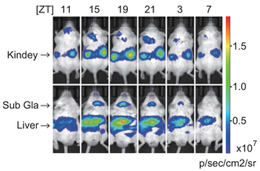Research Abstract
食餌頻度パターンがマウスの末梢概日時計の位相を決定する
Meal frequency patterns determine the phase of mouse peripheral circadian clocks
2012年10月5日 Scientific Reports 2 : 711 doi: 10.1038/srep00711

哺乳類における末梢の概日時計は、明暗周期や摂食周期に強く影響される。これらの生理学的機能は、時計遺伝子の発現パターンを介して、器官の位相を同調することにより維持されている。しかし、一日に複数回行われる食事のタイミングに対する末梢時計の順応については、あまりわかっていない。本研究では、タイミングと量に関して不規則な摂食パターンが、in vivoでの末梢時計へ及ぼす影響を調べた。末梢時計の位相は、食餌の量と摂食時間の間隔により変化するが、間隔が固定されていれば摂食頻度には影響されないことがわかった。さらに今回の結果は、末梢時計の位相が不規則になることを軽減するためには、遅めの夕食は半分ずつ2回に分けるべきであることを示唆している。
- 早稲田大学 先進理工学部 生理・薬理研究室
*本研究は、黒田 大暁、田原 優の2研究者が同等に貢献した成果として論文発表しています。
Peripheral circadian clocks in mammals are strongly entrained by light-dark and eating cycles. Their physiological functions are maintained by the synchronization of the phase of organs via clock gene expression patterns. However, little is known about the adaptation of peripheral clocks to the timing of multiple daily meals. Here, we investigated the effect of irregular eating patterns, in terms of timing and volume, on their peripheral clocks in vivo. We found that the phase of the peripheral clocks was altered by the amount of food and the interval between feeding time points but was unaffected by the frequency of feeding, as long as the interval remained fixed. Moreover, our results suggest that a late dinner should be separated into 2 half-dinners in order to alleviate the effect of irregular phases of peripheral clocks.

